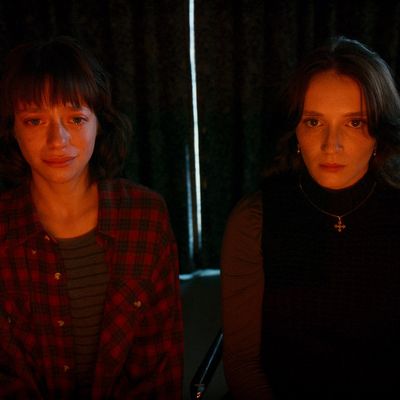
There are no real red rooms in Canadian director Pascal Plante’s unnerving thriller Red Rooms. Mostly a lot of white, gray, blank ones — from the bare and futuristically antiseptic courtroom where a grisly trial is taking place, to the minimalist high-rise Montreal apartment where the film’s protagonist lives, to the squash courts where she takes out her anger. The title refers to the horrific, blood-soaked dungeons where, it is alleged, the serial killer on trial — Ludovic Chevalier, also known as “the Demon of Rosemont” and played wordlessly by Maxwell McCabe-Lokos with saucer-eyed, predatory calm — mutilated his teenage victims while livestreaming the slaughter for money. We do witness distant flashes of such a room at one point, but the idea mostly looms over the film like an unseen dimension, a psychotic alternate reality beneath and beyond the eerie, empty drabness of modern life.
Plante’s interest lies not so much in the criminal or his victims but on the people obsessed with him. The film (which is now available on demand and playing in select theaters) follows Kelly-Anne (Juliette Gariépy), a statuesque and mostly expressionless professional model who gets in line early every night to get into the small courtroom in the morning. Deep into the world of the dark web, Kelly-Anne spends much of her time playing online poker with Bitcoin and hacking into other people’s private lives — even accessing the email accounts and security codes for the grieving parents of the Demon’s victims. Kelly-Anne doesn’t show much emotion, but Plante often accompanies her scenes with wailing, operatic music that is as expressive as she is not. She also meets another serial killer groupie who could be her polar opposite in personality, Clémentine (Laurie Babin), a manic chatterbox who genuinely believes Chevalier must be innocent because his big eyes are too kind. (His eyes, by the way, are not kind — and Plante makes fine use of them in one of the film’s more striking scenes.)
There is no real bloodshed in Red Rooms, but there is a kind of spiritual savagery. Plante achieves this partly through subtraction: Confronted with a verbal accounting of the Demon’s unspeakable crimes, Kelly-Anne’s poker-faced fascination with the trial is increasingly hard to read. Is she drawn to Chevalier and his alleged acts, or repulsed by them? This is among the many questions that hang in the air for most of Red Rooms’ running time, and the unnerving mystery of Kelly-Anne’s psyche, combined with the ease with which she moves through the shady corners of the internet, present a portrait of a very modern soul — unreadable, unstable, and unsettling.
At the same time, the initially controlled direction of the film — with its long, deliberate tracking shots, and orderly spaces — suggests a character who is herself fully in control of herself and her surroundings. Kelly-Anne might be unwell, but she’s also quite cool. This contrasts sharply with the messy behavior of Clémentine, who during one of the movie’s more bravura sequences calls into a late-night talk show to try and defend Chevalier, only to reveal how unhinged she really sounds. But as Red Rooms proceeds, Kelly-Anne’s reality also begins to slip, and the film’s style becomes looser, more frantic and fragmented. So much so that we might even start to question the veracity of what we’re seeing.
Despite the (thankful) lack of gore and violence, Red Rooms feels curiously giallo-adjacent at times. The bursts of formalism, the melodramatic score, the ways in which the model-protagonist’s own profession becomes a stylistic barometer for her mental state — these are all evocative of that classic, colorful subgenre of horror. What’s missing is the tongue-in-cheek exploitative quality of giallo. Or is it? By denying us cheap thrills, and by pointedly going in the other direction, Red Rooms highlights their absence. This picture about people obsessed with criminals and their grisly crimes confronts us with the mystery of who the obsessives truly are; the questions we ask of Kelly-Anne could also be asked of all us genre fiends. The expressionless, fascinated gaze at the heart of this film is ultimately not the protagonist’s, but our own.
More Movie Reviews
- The Accountant 2 Can Not Be Taken Seriously
- Another Simple Favor Is So Fun, Until It Gets So Dumb
- Errol Morris Has Been Sucked Into the Gaping Maw of True Crime


